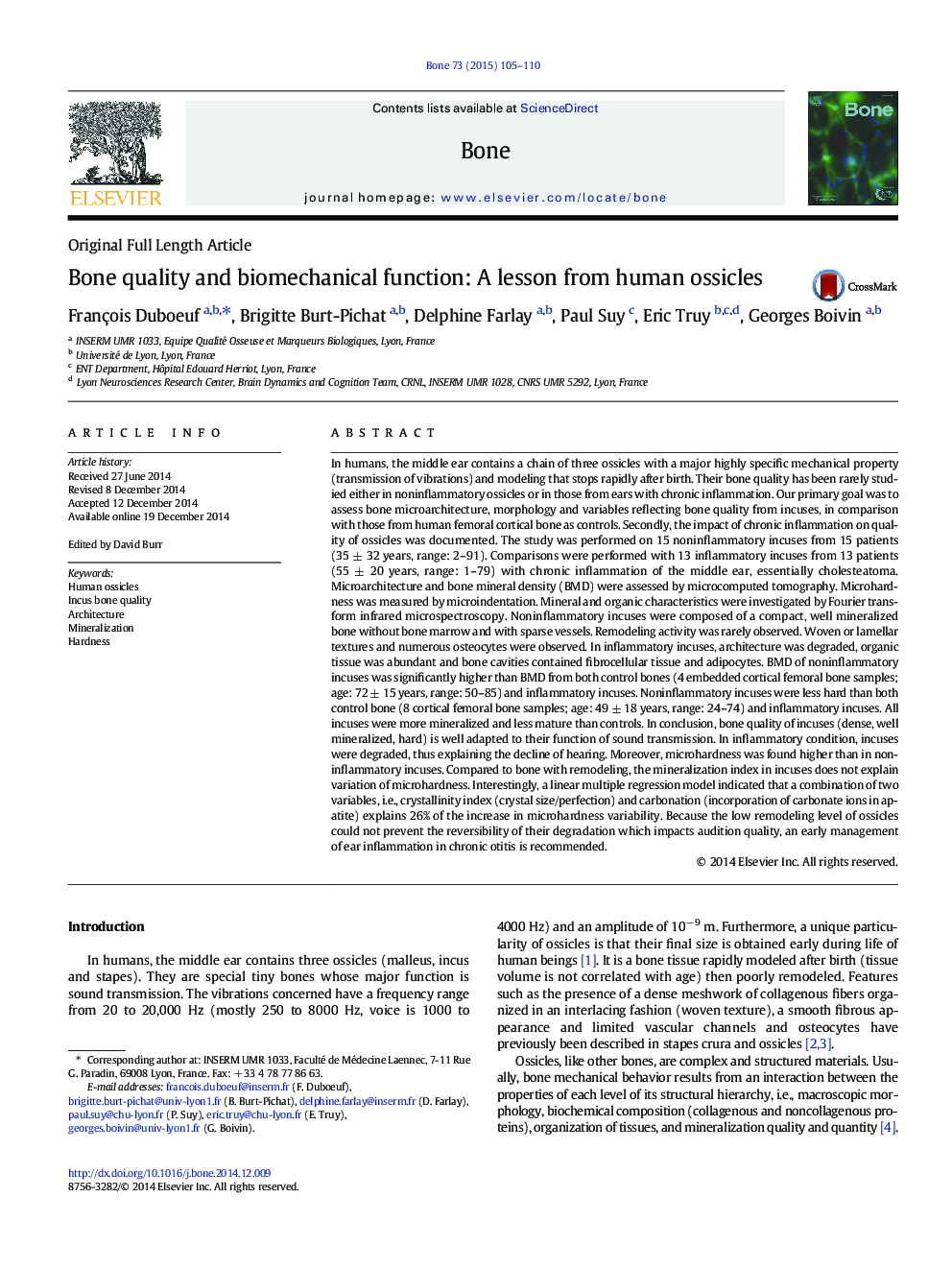| کد مقاله | کد نشریه | سال انتشار | مقاله انگلیسی | نسخه تمام متن |
|---|---|---|---|---|
| 5889938 | 1568146 | 2015 | 6 صفحه PDF | دانلود رایگان |
عنوان انگلیسی مقاله ISI
Bone quality and biomechanical function: A lesson from human ossicles
ترجمه فارسی عنوان
کیفیت استخوان و عملکرد بیومکانیک: یک درس از استخوان ها انسان
دانلود مقاله + سفارش ترجمه
دانلود مقاله ISI انگلیسی
رایگان برای ایرانیان
کلمات کلیدی
استخوان های بدن انسان، کیفیت استخوان انسک، معماری، معدنی شدن، سختی
موضوعات مرتبط
علوم زیستی و بیوفناوری
بیوشیمی، ژنتیک و زیست شناسی مولکولی
زیست شناسی تکاملی
چکیده انگلیسی
In humans, the middle ear contains a chain of three ossicles with a major highly specific mechanical property (transmission of vibrations) and modeling that stops rapidly after birth. Their bone quality has been rarely studied either in noninflammatory ossicles or in those from ears with chronic inflammation. Our primary goal was to assess bone microarchitecture, morphology and variables reflecting bone quality from incuses, in comparison with those from human femoral cortical bone as controls. Secondly, the impact of chronic inflammation on quality of ossicles was documented. The study was performed on 15 noninflammatory incuses from 15 patients (35 ± 32 years, range: 2-91). Comparisons were performed with 13 inflammatory incuses from 13 patients (55 ± 20 years, range: 1-79) with chronic inflammation of the middle ear, essentially cholesteatoma. Microarchitecture and bone mineral density (BMD) were assessed by microcomputed tomography. Microhardness was measured by microindentation. Mineral and organic characteristics were investigated by Fourier transform infrared microspectroscopy. Noninflammatory incuses were composed of a compact, well mineralized bone without bone marrow and with sparse vessels. Remodeling activity was rarely observed. Woven or lamellar textures and numerous osteocytes were observed. In inflammatory incuses, architecture was degraded, organic tissue was abundant and bone cavities contained fibrocellular tissue and adipocytes. BMD of noninflammatory incuses was significantly higher than BMD from both control bones (4 embedded cortical femoral bone samples; age: 72 ± 15 years, range: 50-85) and inflammatory incuses. Noninflammatory incuses were less hard than both control bone (8 cortical femoral bone samples; age: 49 ± 18 years, range: 24-74) and inflammatory incuses. All incuses were more mineralized and less mature than controls. In conclusion, bone quality of incuses (dense, well mineralized, hard) is well adapted to their function of sound transmission. In inflammatory condition, incuses were degraded, thus explaining the decline of hearing. Moreover, microhardness was found higher than in noninflammatory incuses. Compared to bone with remodeling, the mineralization index in incuses does not explain variation of microhardness. Interestingly, a linear multiple regression model indicated that a combination of two variables, i.e., crystallinity index (crystal size/perfection) and carbonation (incorporation of carbonate ions in apatite) explains 26% of the increase in microhardness variability. Because the low remodeling level of ossicles could not prevent the reversibility of their degradation which impacts audition quality, an early management of ear inflammation in chronic otitis is recommended.
ناشر
Database: Elsevier - ScienceDirect (ساینس دایرکت)
Journal: Bone - Volume 73, April 2015, Pages 105-110
Journal: Bone - Volume 73, April 2015, Pages 105-110
نویسندگان
François Duboeuf, Brigitte Burt-Pichat, Delphine Farlay, Paul Suy, Eric Truy, Georges Boivin,
